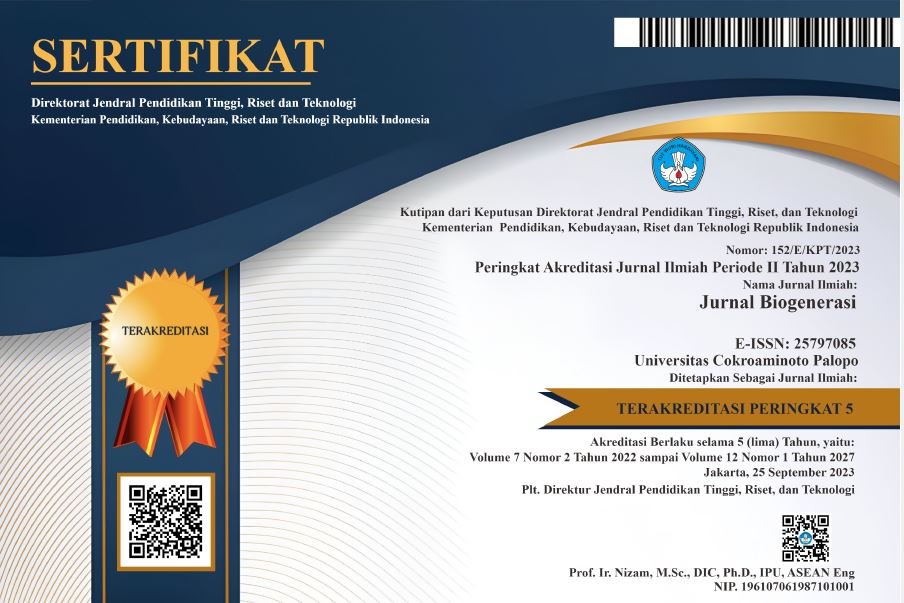PENGGUNAAN PUPUK HAYATI PADAT ORGANIK TERHADAP PERTUMBUHAN DAN BOBOT HASIL PANEN TANAMAN KEMBANG KOL
DOI:
https://doi.org/10.30605/biogenerasi.v10i2.5397Keywords:
Result Weight, Cauliflower, Growth, Solid Bio-FertilizerAbstract
Cauliflower (Brassica oleracea var. botrytis L.) is one of the vegetables widely consumed by Indonesian people. Cauliflower productivity in Indonesia has decreased in recent years. Plant growth and production can be influenced by internal factors of the plant itself and external factors such as climate, soil, sunlight intensity, nutrients, and OPT. Fulfillment of plant nutritional needs is done by providing fertilizers, both organic fertilizers (biological and non-biological) and inorganic fertilizers. This study aims to test the use of organic solid biofertilizers on the growth and weight of cauliflower harvests. The research method used was a randomized block design (RAK) consisting of 6 treatments and 4 replications to obtain 24 experimental units. The treatments used were treatment A (100% solid biofertilizer), treatment B (solid biofertilizer + 75% dose of inorganic fertilizer), treatment C (solid biofertilizer + 50% dose of inorganic fertilizer), treatment D (solid biofertilizer + 25% dose of inorganic fertilizer), treatment E (100% dose of inorganic fertilizer), and treatment F (without fertilization/control). The results showed a significant effect on the provision of solid biofertilizer and inorganic fertilizer on plant height, number of leaves, and wet weight of the harvest, while the stem diameter had no significant effect. Meanwhile, there was no significant difference between the treatments of using solid biofertilizer and inorganic fertilizer.
Downloads
References
Asril, M., Ningsih, H., Basuki, Suhastyo, A. A., Septyani, I. A. P., Abidin, Z., Mahyati, Saadah, T. T., Paulina, M., Siahaan, A. S.A., Hasfiah, & Tang, J. (2023). Kesuburan dan Pemupukan Tanah. Yayasan Kita Menulis.
Cahyono, B. (2011). Kubis Bunga dan Broccoli. Yogyakarta: Kanisius.
Candraningtyas, C. F., & Indrawan, M. (2023). Analisis Efektivitas Penggunaan Plant Growth Promoting Rhizobacteria (PGPR) Untuk Peningkatan Pertanian Berkelanjutan. Risalah Kebijakan Pertanian dan Lingkungan, 10(2), 88-99.
Dewi, S. M., Ningtyas, D. N. Y., Amalia, I. S., & Ramadhan, R. A. M. (2024). Respons Pertumbuhan Tanaman Jagung (Zea mays L.) Terhadap Pemberian Beberapa Dosis Pupuk Hayati Trichoderma sp. Biogenerasi: Jurnal Pendidikan Biologi, 9(1), 670-675.
Endarwati, D., Maryono, T., Pramono, S., Akin, H. M., Pranata, H., & Saefudin. (2024). Pengaruh Faktor Lingkungan Terhadap Pertumbuhan Miselium Xylaria sp. Penyebab Penyakit Lapuk Akar dan Pangkal Batang Tebu. Jurnal Agrotek Tropika, 12(3), 571-577.
Erlambang, R., Yamika, W. S. D., & Suryanto, A. (2018). Uji Efektivitas Pupuk Hayati pada Pertumbuhan dan Produktifitas Tanaman Terung (Solanum melongena L.). Jurnal Produksi Tanaman, 6(9), 2338-2345.
Erwin, S., Ramli, & Andrianton. (2015). Pengaruh Berbagai Jarak Tanam pada Pertumbuhan dan Produksi Kubis (Brassica oleracea L.) di Dataran Menengah Desa Bobo Kecamatan Palolo Kabupaten Sigi. Jurnal Agroteknis, 3(4), 491-497.
Etesami, H., & Adl, S. M. (2020). Plant Growth-Promoting Rhizobacteria (PGPR) and Their Action Mechanisms in Availability of Nutrients to Plants. In M. Kumar, V. Kumar, & R. Prasad (Eds.), Phyto-Microbiome in Stress Regulation (pp. 147–203). Springer, Singapore. https://doi.org/10.1007/978-981-15-2576-6_9
Fadillah, N., Sutariati, G. A. K., & Rakian, T. C. (2021). Efektivitas Kombinasi Pupuk Organik Plus dan Anorganik Berbasis Leisa Terhadap Pertumbuhan dan Hasil Bawang Merah. Jurnal Agrotech, 11(2), 56-63.
Ginting, E. N. (2024). Pupuk Kimia, Pupuk Organik, atau Pupuk Hayati? Memahami Filosofi Pemupukan untuk Perkebunan Kelapa Sawit yang Berkelanjutan. Warta PPKS, 29(3), 147-160.
Glick, B. R. (2012). Plant Growth-Promoting Bacteria: Mechanisms and Applications. Scientifica, 5, 1-15.
Hidayat, F., Yudhistira, Y., Pane, R. D. P., Sapalina, F., Listia, E., Amalia, R., Muhayat, & Winarna. (2023). Aplikasi Pupuk Hayati Untuk Meningkatkan Pertumbuhan dan Produktivitas Tanaman Kelapa Sawit. J. Pen. Kelapa Sawit, 31(2), 96-107.
Hindersah, R., Kalay, M., Talahaturuson, A., & Lakburlawal, Y. (2018). Bakteri Pemfiksasi Nitrogen Azotobacter Sebagai Pupuk Hayati dan Pengendali Penyakit pada Tanaman Kacang Panjang. Agric: Jurnal Ilmu Pertanian, 30(1), 25-32.
Ichwan, B., Novita, T., Eliyanti, & Masita, E. (2021). Aplikasi Berbagai Jenis Plant Growth Promoting Rhizobacteria (PGPR) dalam Meningkatkan Pertumbuhan dan Hasil Cabai Merah (Capsicum annuum L.). Jurnal Media Pertanian, 6(1), 1-7.
Jaenudin, A., & Sugesa, N. (2018). Pengaruh Pupuk Kandang dan Cendawan Mikoriza Arbuskular terhadap Pertumbuhan, Serapan N, dan Hasil Tanaman Kubis (Brassica oleracea var. botrytis L.). Jurnal Agroswagati, 6(1), 667-677.
Jannah, M., Jannah, R., & Fahrunsyah. (2022). Kajian Literatur: Penggunaan Plant Growth Promoting Rhizobacteria (PGPR) untuk Meningkatkan Pertumbuhan dan Mengurangi Pemakaian Pupuk Anorganik pada Tanaman Pertanian. Jurnal Agroekoteknologi Tropika Lembab, 5(1), 41-49.
Karimah, A. D., & Koesriharti. (2022). Pengaruh Inokulasi Rhizobium dan Pupuk Anorganik NPK terhadap Pertumbuhan dan Hasil Tanaman Kedelai (Glycine Max (L.) Merril). Jurnal Produksi Tanaman, 10(12), 684-693.
Lekatompessy, S. J.R., & Nurjanah, L. (2019). Pengaruh Pemberian Kombinasi Pupuk Hayati dan Pupuk Organik pada Tanaman Padi Gogo. Prosiding Seminar Nasional Masyarakat Biodiversitas Indonesia, 5(2), 222-227.
Liang, Y., Pan, F., Jiang, Z., Li, Q., Pu, J., & Liu, K. (2022). Accumulation in nutrient acquisition strategies of arbuscular mycorrhizal fungi and plant roots in poor and heterogeneous soils of karst shrub ecosystems. BMC Plant Biology, 22(1).
Lidar, S., & Tumorang, M. (2024). Respon Pertumbuhan dan Produksi Bunga Kol (Brassica oleracea var. botrytis L) Akibat Pemberian Pupuk Organik Cair dan Pupuk NPK. Jurnal Agrotela, 5(2), 87-97.
Maftuah, E., & Hayati, A. (2019). Pengaruh Persiapan Lahan dan Penataan Lahan terhadap Sifat Tanah, Pertumbuhan dan Hasil Cabai Merah (Capsicum annum) di Lahan Gambut. J. Hort. Indonesia, 10(2), 102-111.
Makmur, & Sainuddin, D. U. (2020). Pengaruh Berbagai Metode Aplikasi Pupuk Terhadap Pertumbuhan dan Produksi Tanaman Jagung (Zea mays L.). Agrovital: Jurnal Ilmu Pertanian, 5(1), 11-16.
Maknuna, L. L., & Soeparjono, S. (2023). Pengaruh Aplikasi Bakteri Azotobacter sp. dan Dosis Pupuk Kotoran Kambing terhadap Serapan Nitrogen, Pertumbuhan dan Hasil Tanaman Jagung (Zea mays L.). Plumula: Berkala Ilmiah Agroteknologi, 11(2), 112-131.
Margaret, S., Yusup, A. M., & Sasmita, P. (2016). Pengaruh Pupuk Hayati dan Dosis Pupuk NPK Anorganik Terhadap Pertumbuhan dan Hasil Padi Inpari 32. Kementerian Pertanian, 157-164.
Mohanty, P., Singh, P. K., Chakraborty, D., Mishra, S., & Pattnaik, R. (2021). Insight Into the Role of PGPR in Sustainable Agriculture and Environment. Frontiers in Sustainable Food Systems, 5.
Noertjahyani, Ria, E. R., Romiyadi, & Hanati, A. N. (2024). Pertumbuhan dan Hasil Tanaman Bawang Merah (Allium ascalonicum L.) Varietas Bima Brebes Akibat Dosis PGPR Akar Bambu. Orchid Agro, 4(2), 28-36.
Popoola, B. M., Famakinwa, P. B., & Adeyemi, O. A. (2022). Isolation of Microorganisms Associated with Palm Oil Contaminated Soil. Journal of Environmental Pollution and Control, 5(2), 1-12.
Rana, A., Setiawati, M. R., & Suriadikusumah, A. (2018). Pengaruh Pupuk Hayati dan Anorganik Terhadap Populasi Bakteri Pelarut Fosfat, Kandungan Fosfat (P), dan Hasil Tomat Hidroponik. Jurnal Biodjati, 3(1), 15-22.
Ratule, M. T. (2024). Buku ATAP Hortikultura. Kementerian Pertanian Republik Indonesia.
Ridwan, Wardah, & Ariani, D. (2020). Kombinasi Pupuk Organik dan Anorganik untuk Optimalisasi Produksi dan Kandungan Nutrisi Umbi Taka. Jurnal Agronomi Indonesia, 48(2), 150-156.
Safitri, R., Zaira, B., & Rossiana, N. (2014). Biodegradation of Palm Oil Effluent by Consortium of Bacillus sp., Phanerochaete chrysosporium and Trichoderma viride. AgroLife Scientific Journal, 3(1), 126-132.
Sari, R., & Prayudyaningsih, R. (2015). Rhizobium: Pemanfaatannya Sebagai Bakteri Penambat Nitrogen. Info Teknis EBONI, 12(1), 51-64.
Schoebitz, M., & Vidal, G. (2016). Microbial consortium and pig slurry to improve chemical properties of degraded soil and nutrient plant uptake. Journal of Soil Science and Plant Nutrition, 16(1), 226-236.
Setiawati, M. R., Utami, D. S., Hindersah, R., Herdiyantoro, D., & Suryatmana, u. (2021). Pemanfaatan Limbah Pertanian dalam Menurunkan Dosis Pupuk Anorganik, Meningkatkan Populasi Azospirillum sp. , Nitrogen tanah, Serapan Nitrogen, dan Hasil Jagung pada Inceptisols Jatinangor. Soilrens, 19(1), 9-19.
Sitawati, Sintawati, M. B., & Fajriani, S. (2022). Efektivitas Plant Growth Promotion Rhizobacteria (PGPR) dan Pupuk NPK terhadap Pertumbuhan dan Pembungaan Tanaman Aster ericoides (Symphyotrichum ericoides). J. Hort. Indonesia, 13(2), 64-71.
Situmorang, A. S. (2022). Isolation and Nodulation Test of Rhizobium sp. from Pueraria javanica (Benth.) Benth. and Liability Test on The Carrier Medium of Peat and Compost from Palm Oil Palm Empty Fruits. Jurnal Matematika dan Ilmu Pengetahuan Alam LLDikti Wilayah 1 (JUMPA), 2(1), 12-24.
Suyal, D. C., Soni, R., Rai, S., & Goel, R. (2016). Microbial Inoculants in Sustainable Agricultural Productivity. New Delhi: Springer.
Vocciante, M., Grifoni, M., Fusini, D., & Petruzzelli, G. (2022). The Role of Plant Growth-Promoting Rhizobacteria (PGPR) in Mitigating Plant’s Environmental Stresses. Applied Sciences, 12(3), 1231.
Yurnaliza, Nurwahyuni, I., Lenny, S., & Lutfia, A. (2024). Bioprospecting Study of Plant Growth Promoting Rhizospheric Bacteria from Oil Palm Plantation as Biological Control Agent of Ganoderma boninense. Pakistan Journal of Biological Sciences, 27, 256-267.
Ziladi, A. R., Hendarto, K., Ginting, Y. C., & Karyanto, A. (2021). Pengaruh Jenis Pupuk Organik dan Aplikasi Pupuk Hayati Terhadap Pertumbuhan dan Produksi Tanaman Tomat (Solanum lycopersicum Mill) di Desa Sukabanjar Kecamatan Gedong Tataan. Jurnal Agrotek Tropika, 9(1), 145-151.
Downloads
Published
How to Cite
Issue
Section
License
In submitting the manuscript to the journal, the authors certify that:
- They are authorized by their co-authors to enter into these arrangements.
- The work described has not been formally published before, except in the form of an abstract or as part of a published lecture, review, thesis, or overlay journal.
- That it is not under consideration for publication elsewhere,
- That its publication has been approved by all the author(s) and by the responsible authorities – tacitly or explicitly – of the institutes where the work has been carried out.
- They secure the right to reproduce any material that has already been published or copyrighted elsewhere.
- They agree to the following license and copyright agreement.
License and Copyright Agreement
Authors who publish with this journal agree to the following terms:
- Authors retain copyright and grant the journal right of first publication with the work simultaneously licensed under Creative Commons Attribution License (CC BY 4.0) that allows others to share the work with an acknowledgment of the work's authorship and initial publication in this journal.
- Authors are able to enter into separate, additional contractual arrangements for the non-exclusive distribution of the journal's published version of the work (e.g., post it to an institutional repository or publish it in a book), with an acknowledgment of its initial publication in this journal.
- Authors are permitted and encouraged to post their work online (e.g., in institutional repositories or on their website) prior to and during the submission process, as it can lead to productive exchanges, as well as earlier and greater citation of published work.


.png)

